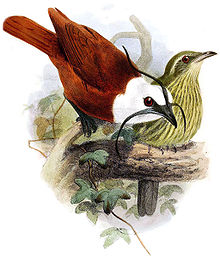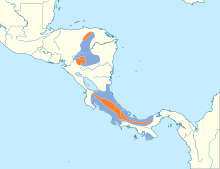291:, the three-wattled bellbird is between 25 cm (9.8 in) and 30 cm (12 in) long. The body, tail, and wings of the male are uniformly chestnut-brown; its head, neck, and upper breast are white; and it has a black eye-ring, eye-stripe, and bill. Its name comes from the three worm-like wattles of skin that hang from the base of the bill. These wattles can be as long as 10 cm (3.9 in) when extended during songs and interactions. The wattles remain flaccid even when extended. The male shakes the wattles, but otherwise they hang straight down; they are neither erectile nor under muscular control. The side wattles do not stick out to the sides and the central one is not extended directly skywards as shown on some old illustrations and
382:
31:
206:
80:
370:
55:
390:
be among the loudest bird calls on Earth, audible to humans from over 0.5 mi (0.80 km) away. The song is different in
Nicaragua and also in Panama, and these songs also include an extremely loud, but less bell-like, note. The song may also be a short "Heee-Ahhh." In some instances, it has been described as sounding like microphone feedback.
343:
The bellbird has its own unique mating ritual. The male birds sneak up behind the females perching on a high branches. As the male quietly approaches the female, he opens his mouth a full 180 degrees to make his distinctive "bonk" sound in her ear, knocking the female off of her branch. They repeat
389:
Because of the secretive behavior of this bird, it is often only detected by the distinctive bell-like call given by the males. At close range, the vocalization of many in Costa Rica is heard as a complex three-part song, the "bonk" giving the bird its name. This hollow, wooden "bonk" is thought to
306:
Juvenile males are often confused with females; they have the same coloring as females until they reach sexual maturity at age 7. As they age, the males slowly molt the green and brown feathers and begin to grow the striking white and copper coat. They do not begin to grow their wattles until they
298:
The female bellbirds are smaller and less striking in appearance, being overall olive with yellowish streaking below, pure yellow vent and no wattles. The females blend into the surroundings of the forest, which helps them hide its nests from predators. The nests are very difficult to spot. As of
251:
family. The sexes are very dissimilar in appearance. The male has a white head and throat and the remaining plumage is chestnut brown. From the base of his beak dangle three long, slender, black wattles that he uses in display. The female has olive plumage with yellowish streaked underparts and a
420:
in Costa Rica is working to conserve the bellbird's natural habitat through its reforestation program. The organization has planted over 250,000 trees of more than 140 species in the
Bellbird Biological Corridor in attempt to bridge the habitats that many species require for migration.
360:
family, of which the avocado is a member. The bellbird performs an important role in seed dispersal. It regurgitates the seeds it cannot digest and deposits them in gap areas beneath song perches, which nearly doubles seedling survival rate.
300:
393:
Research by Donald
Kroodsma on recordings archived at the Cornell Lab of Ornithology showed that the three-wattled bellbird is unique among members of its
397:, in that it learns its song, rather than having the song determined by instinct, because the song changed over the years that it had been recorded.
903:
406:
268:
315:
Famous for having one of the most unusual and distinct vocalizations of any bird in its range, the three-wattled bellbird exists from western
803:
267:. The male bird has a loud, distinctive, bell-like call, and as these birds are secretive and shy, they are more often heard than seen. The
575:
Life
Histories of Central American Birds III: Families Cotingidae, Pipridae, Formicariidae, Furnariidae, Dendrocolaptidae, and Picidae
883:
589:
751:
405:
The population trend of the three-wattled bellbird is on a downward trend because of destruction of the bird's forest habitat. The
777:
782:
654:
557:
908:
808:
681:
344:
this sequence, and after the courtship is over, the female departs to build the nest and raise the chicks alone.
567:
821:
898:
577:. Pacific Coast Avifauna, Number 35. Berkeley, California: Cooper Ornithological Society. pp. 85–91.
893:
598:
465:
694:
79:
816:
490:
594:
668:
381:
307:
are 1 to 2 years old, and the wattles continue to grow for the entirety of the male bird's life.
377:(in living individuals, the three elongated wattles typically hang loosely down beside the bill)
702:
616:
255:
The three-wattled bellbird breeds in mountainous regions of Costa Rica and migrates to western
795:
527:
174:
847:
299:
January 2019, only six nests had been found in
Monteverde, according to the council for the
707:
663:
284:
151:
860:
604:
8:
374:
292:
44:
442:
195:
410:
272:
213:
74:
59:
30:
888:
842:
725:
553:
505:
730:
563:
460:
829:
717:
241:
639:
244:
205:
191:
877:
790:
451:
288:
64:
328:
369:
834:
764:
648:
855:
756:
545:
324:
506:"Advantages of seed dispersal: A re-evaluation of directed dispersal"
394:
357:
353:
332:
260:
131:
91:
769:
610:
417:
743:
633:
316:
256:
111:
689:
248:
141:
676:
320:
264:
101:
436:
434:
738:
431:
121:
550:
The
Cotingas: Bellbirds, Umbrella birds and their allies.
331:(March–September) and return to lower elevations in the
440:
466:10.2305/IUCN.UK.2016-3.RLTS.T22700946A93806341.en
875:
407:International Union for Conservation of Nature
269:International Union for Conservation of Nature
409:has assessed their conservation status as "
356:; it swallows the fruits from trees in the
271:has assessed their conservation status as "
485:
483:
295:. The purpose of the wattles is unclear.
204:
53:
29:
464:
380:
368:
904:Birds of the Talamancan montane forests
480:
876:
615:
614:
503:
452:IUCN Red List of Threatened Species
13:
538:
14:
920:
583:
884:IUCN Red List vulnerable species
78:
595:Photos, videos and observations
441:BirdLife International (2016).
323:. Bellbirds breed primarily in
310:
38:Male (left) and female (right)
520:
497:
278:
1:
424:
607:on the xeno canto collection
301:Bellbird Biological Corridor
7:
599:Cornell Lab of Ornithologys
590:BirdLife Species Factsheet.
10:
925:
352:The species is completely
347:
623:
400:
338:
335:for the interim months.
287:that live in Central and
219:
212:
203:
180:
173:
75:Scientific classification
73:
51:
42:
37:
28:
23:
861:Procnias-tricarunculatus
682:procnias-tricarunculatus
669:Procnias_tricarunculatus
655:Procnias tricarunculatus
625:Procnias tricarunculatus
568:"Three-wattled bellbird"
491:"Three-Wattled Bellbird"
459:: e.T22700946A93806341.
445:Procnias tricarunculatus
237:Procnias tricarunculatus
184:Procnias tricarunculatus
909:Birds described in 1853
528:"Reforestation Program"
364:
283:One of four species of
222:Procnias tricarunculata
166:P. tricarunculatus
24:Three-wattled bellbird
552:British Museum Press.
386:
378:
232:three-wattled bellbird
504:Wenny, Dan W (2001).
384:
372:
564:Skutch, Alexander F.
418:Monteverde Institute
252:yellow vent area.
45:Conservation status
899:Birds of Nicaragua
601:Birds of the World
387:
385:Male in Costa Rica
379:
894:Birds of Honduras
871:
870:
843:Open Tree of Life
617:Taxon identifiers
373:Taxidermied male
327:highlands in the
319:south to eastern
228:
227:
68:
916:
864:
863:
851:
850:
838:
837:
825:
824:
812:
811:
799:
798:
786:
785:
773:
772:
760:
759:
747:
746:
734:
733:
721:
720:
711:
710:
698:
697:
695:7818C61C6F3AC360
685:
684:
672:
671:
659:
658:
657:
644:
643:
642:
612:
611:
578:
572:
532:
531:
524:
518:
517:
501:
495:
494:
487:
478:
477:
475:
473:
468:
438:
242:Central American
208:
186:
83:
82:
62:
57:
56:
33:
21:
20:
924:
923:
919:
918:
917:
915:
914:
913:
874:
873:
872:
867:
859:
854:
846:
841:
833:
830:Observation.org
828:
820:
815:
807:
802:
794:
789:
781:
776:
768:
763:
755:
750:
742:
737:
729:
724:
716:
714:
706:
701:
693:
688:
680:
675:
667:
662:
653:
652:
647:
638:
637:
632:
619:
605:Calls and songs
586:
581:
570:
562:
541:
539:Further reading
536:
535:
526:
525:
521:
510:Evol. Ecol. Res
502:
498:
489:
488:
481:
471:
469:
439:
432:
427:
403:
367:
350:
341:
313:
281:
199:
188:
182:
169:
77:
69:
58:
54:
47:
17:
16:Species of bird
12:
11:
5:
922:
912:
911:
906:
901:
896:
891:
886:
869:
868:
866:
865:
852:
839:
826:
813:
800:
787:
774:
761:
748:
735:
722:
712:
699:
686:
673:
660:
645:
629:
627:
621:
620:
609:
608:
602:
592:
585:
584:External links
582:
580:
579:
560:
542:
540:
537:
534:
533:
519:
496:
479:
429:
428:
426:
423:
402:
399:
366:
363:
349:
346:
340:
337:
312:
309:
280:
277:
245:migratory bird
226:
225:
217:
216:
210:
209:
201:
200:
189:
178:
177:
171:
170:
163:
161:
157:
156:
149:
145:
144:
139:
135:
134:
129:
125:
124:
119:
115:
114:
109:
105:
104:
99:
95:
94:
89:
85:
84:
71:
70:
52:
49:
48:
43:
40:
39:
35:
34:
26:
25:
15:
9:
6:
4:
3:
2:
921:
910:
907:
905:
902:
900:
897:
895:
892:
890:
887:
885:
882:
881:
879:
862:
857:
853:
849:
844:
840:
836:
831:
827:
823:
818:
814:
810:
805:
801:
797:
792:
788:
784:
779:
775:
771:
766:
762:
758:
753:
749:
745:
740:
736:
732:
727:
723:
719:
713:
709:
704:
700:
696:
691:
687:
683:
678:
674:
670:
665:
661:
656:
650:
646:
641:
635:
631:
630:
628:
626:
622:
618:
613:
606:
603:
600:
596:
593:
591:
588:
587:
576:
569:
565:
561:
559:
558:0-19-858511-X
555:
551:
547:
544:
543:
529:
523:
515:
511:
507:
500:
492:
486:
484:
467:
462:
458:
454:
453:
448:
446:
437:
435:
430:
422:
419:
414:
412:
408:
398:
396:
391:
383:
376:
371:
362:
359:
355:
345:
336:
334:
330:
326:
322:
318:
308:
304:
302:
296:
294:
290:
289:South America
286:
276:
274:
270:
266:
262:
258:
253:
250:
246:
243:
239:
238:
233:
224:
223:
218:
215:
211:
207:
202:
197:
193:
187:
185:
179:
176:
175:Binomial name
172:
168:
167:
162:
159:
158:
155:
154:
150:
147:
146:
143:
140:
137:
136:
133:
132:Passeriformes
130:
127:
126:
123:
120:
117:
116:
113:
110:
107:
106:
103:
100:
97:
96:
93:
90:
87:
86:
81:
76:
72:
66:
61:
50:
46:
41:
36:
32:
27:
22:
19:
624:
574:
549:
522:
513:
509:
499:
470:. Retrieved
456:
450:
444:
415:
404:
392:
388:
351:
342:
329:cloud forest
314:
311:Distribution
305:
297:
282:
254:
236:
235:
231:
229:
221:
220:
183:
181:
165:
164:
152:
18:
817:Neotropical
765:iNaturalist
649:Wikispecies
516:(1): 51–74.
472:12 November
354:frugivorous
325:Costa Rican
279:Description
878:Categories
856:Xeno-canto
546:Snow, D.W.
425:References
411:vulnerable
273:vulnerable
142:Cotingidae
60:Vulnerable
395:sub-order
358:Lauraceae
333:mangroves
293:specimens
261:Nicaragua
160:Species:
98:Kingdom:
92:Eukaryota
889:Procnias
796:22700946
708:22700946
703:BirdLife
640:Q1060452
634:Wikidata
566:(1969).
548:(1982).
375:specimen
317:Honduras
285:bellbird
257:Honduras
214:Synonyms
196:Verreaux
192:Verreaux
153:Procnias
138:Family:
112:Chordata
108:Phylum:
102:Animalia
88:Domain:
65:IUCN 3.1
757:2486403
690:Avibase
348:Ecology
249:cotinga
247:of the
240:) is a
198:, 1853)
148:Genus:
128:Order:
118:Class:
63: (
848:825824
822:thwbel
809:462351
783:711492
744:thwbel
718:thwbel
677:ARKive
556:
401:Status
339:Mating
321:Panama
265:Panama
194:&
835:74209
739:eBird
731:4MNX7
715:BOW:
571:(PDF)
804:NCBI
791:IUCN
778:ITIS
770:8847
752:GBIF
554:ISBN
474:2021
457:2016
416:The
365:Song
263:and
230:The
122:Aves
726:CoL
664:ADW
597:at
461:doi
413:".
303:.
275:".
880::
858::
845::
832::
819::
806::
793::
780::
767::
754::
741::
728::
705::
692::
679::
666::
651::
636::
573:.
512:.
508:.
482:^
455:.
449:.
433:^
259:,
530:.
514:3
493:.
476:.
463::
447:"
443:"
234:(
190:(
67:)
Text is available under the Creative Commons Attribution-ShareAlike License. Additional terms may apply.

